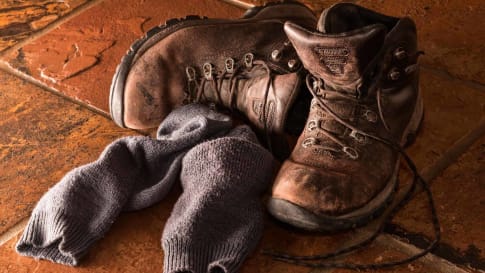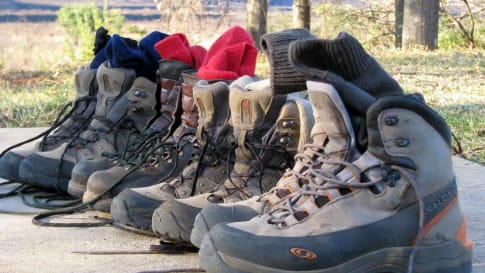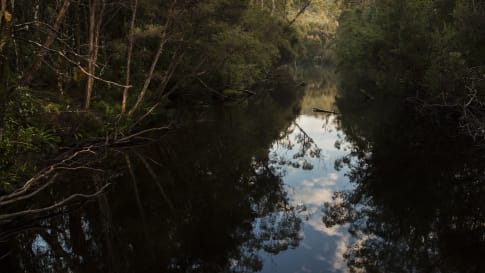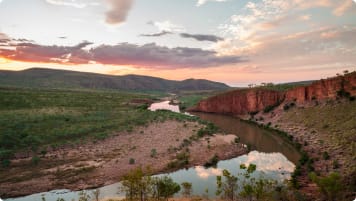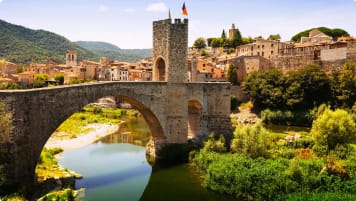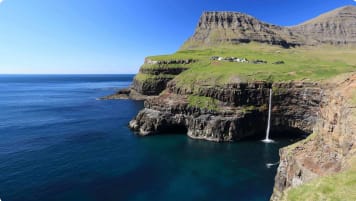Small group tour of Flinders Island
Explore and learn about Flinders Island on an escorted small group tour for mature and senior travellers who enjoy a walking holiday. For couples or solo travellers. We also explore Cradle Mountain and Launceston.
From £4,129GBP

Highlights
- 1. Explore Wybalenna and Furneaux Museum and learn about the history of last settlement of the Tasmanian Aborigines.
- 2. Visit Sawyers Bay and Settlement Point and find out about the history of the first European settlers.
- 3. Enjoy panoramic views from Walkers Lookout.
- 4. View the diverse bird life at Cameron Inlet Wetlands.

Departure Dates
| Departure Date | Price |
|---|---|
| 20 October 2025 Ends 28 October 2025 • 9 days £4,129 Twin £4,856 Single Available | Selected |
| 16 March 2026 Ends 24 March 2026 • days £4,233 Twin £5,012 Single Available | |
| 19 October 2026 Ends 27 October 2026 • days £4,233 Twin £5,012 Single Available | |
| 15 March 2027 Ends 23 March 2027 • days £4,412 Twin £5,272 Single Available | |
| 18 October 2027 Ends 26 October 2027 • days £4,412 Twin £5,272 Single Available |
Small group tour of Flinders Island
Flinders Island , located in the Bass strait of Australia, was mapped by the British explorer Matthew Flinders in 1798. Flinders Island is the largest of the 52 islands that make up the Furneaux group, which is the eastern group of the two groups islands of the coast of northern Tasmania. The group to the west which includes King island is the Hunter group. The island supports a wide variety of abundant wildlife including the protected Cape Barren Goose and a small permanent population of people.
The program is a guided walking small group tour for mature and senior travellers for 9 days. The traveller experiences spectacular scenery, rugged coastline, stunning views often in a wilderness setting. The field trips during this 9-day walking holiday allow the visitor to learn and experience the natural wonders of these southern islands, deep in the Bass Strait. The visitor on this guided walking tour learns about the bird life, the abundant wildlife including sea lions, wildflowers and spectacular scenery along with the amazing geology and fascinating, if not sometimes uncomfortable history.
This guided tour program commences in Launceston, travels to Cradle Mountain and then returns to Launceston before going to Flinders Island.
Located in scenic countryside at the head of the Tamar River, Launceston is Tasmania ’s second largest city and a perfect base for exploring the northeast region of the State. We also have some time in the city to admire the attractive and graceful Victorian-era buildings.
We then travel west to Cradle Mountain, where we will explore some of the many available walking trails. We overnight there, and enjoy some more walking in this beautiful park before we return to Launceston.
This morning we transfer to the airport for the short scenic flight from Tasmania to Flinders island to commence this escorted small group walking tour of Flinders Island.
Flinders Island – Furneaux Group of Islands
Flinders is the largest island of the 52 islands that make up the Furneaux Group. Flinders and the surrounding islands are all that remain of the land bridge that once connected Tasmania to mainland Australia and was still present some 10,000 years ago. Flinders is an island of dramatic landscapes: from Mountainous granite ridges folding down from Mt Killiecrankie to the grey granite cliffs of Killiecrankie bay, to the gentle, green farmland that rolls through the eastern part of the island. It is known for its prolific birdlife; thousands of migratory birds rest here on their long flights to breeding areas north of the Arctic Circle. The history of the Furneaux Islands provides a significant component of the tragic story of the Tasmanian Aboriginals, as well as an account of the early maritime explorers, sealers, shipwrecks and cultural events that are of local and national importance. Much of the region is still exactly as Matthew Flinders found it when he first explored this area years ago.
As the ice age came to an end sea levels rose, and Bass Strait was formed which resulted in Flinders, Cape Barren and Three Hummocks becoming islands and small numbers of Tasmanian Aborigines living here being isolated from the mainland.
The Aboriginal community lived in isolation for several thousands of years until in the 1770's. The oldest archaeological site is an Aboriginal midden, which is some 7,000 years old. The first European to make contact with the islands was Tobias Furneaux, the commander of Captain James Cook's support ship. Furneaux's ship became separated from the Endeavour in fog and it wandered around the east coast of Van Diemen's Land eventually reaching the Furneaux group of islands. It was not known that Flinders Island was separate, and that Van Diemen's Land was not part of mainland Australia until George Bass and Matthew Flinders circumnavigated the main island between October 1798 and June 1799. Governor Philip Gidley King named the strait which separates Tasmania from the mainland after Bass and the main island in the strait after Flinders. The first European settlers on Flinders Island were sealers who lived rough and were only interested in killing seals for their oil, they typically sailed out from Launceston to the islands.
What We Will Experience and see on this small group walking tour of Flinders island.
This small group walking tour of Flinders island is a mix of guided short walks and tours of Flinders Island and some outer islands of the Furneaux group to learn the history, flora, and fauna of this fascinating archipelago.
We focus on the wilderness landscapes, the birds of Bass Strait and wildflowers. We arrive at Lady Barron, situated in the sheltered Adelaide Bay in Franklin Sound at the southern tip of Flinders Island and travel to the west coast. Spectacular scenery can be seen as we drive the coast road to Trousers Point, below the twin peaks of Mt Strzelecki. A short walkaround the point to Fotheringate Bay provides access to the variety of heath plants, birds of low coastal scrub and sea birds. The important history of the island’s early settlers resulting in the last settlement of the Tasmanian Aborigines can be learnt at the Furneaux Museum.
At the northern part of the island we fossick for the ‘Killiecrankie Diamonds’ – white topaz and learn of its development stages and visit the beauty spot of North East River. Our private, charter boat visits some of the outer islands and we see mutton-bird rookeries, home of the short-tailed shearwater and beaches with pacific gulls, cormorants, oyster catchers, sandpipers, fairy terns and possible white-breasted sea eagles.
The Darling Range is the island’s central mountain spine of mountainous granite ridges and our walks on this small group tour take us close to the fascinating rock formations and granite mountain peaks. At the summit of Walkers Hill Lookout, we are rewarded with magnificent views some 360-degrees of Flinders and the island group. Passing through some of the soldier settlement areas of the east coast we visit Patriarch Wildlife Sanctuary where we see Bennett and Padymelon wallabies and Cape Barron geese.
Places to know about on Flinders Island
Whitemark
Whitemark is the main settlement on Flinders Island. It sits on the flat coastal plain with Mount Strzelecki rising to the south. The town, has a population of some 150 people, has all the basic requirements - supermarket, bakery, cafe, post office, hotel etc - and is primarily used as a central point because of its proximity to the airport. In the evening, the hotel is the only place in Whitemark where you can get dinner. In the morning there is a cafe and a bakery.
Sawyers Beach
Only a few kilometres north of the Flinders Island airport is a sign directing visitors to Sawyers Beach which provides excellent views south to Mt Strzelecki and an opportunity to get down onto the beach and explore the remarkable granite rocks with their distinctive red lichen.
Furneaux Museum
The Furneaux Museum contains an extensive collection of artefacts for both the Aboriginal inhabitants on the island and the first European settlers. It recalls the events which shaped the history of the island: the geology, the shipwrecks, muttonbirding, farming, island families, the Soldier Settlement Scheme, the Wybalenna settlement and local fauna and flora.
Wybalenna Historic Site
The story of Aborigines on Flinders Island is a story of maltreatment and misguided attempts to solve a problem while actually exacerbating it. In 1834 a total of 134 Tasmanian Aborigines, believed at the time to be the last of their race, were isolated on the island in an attempt to (a) "civilise and Christianise" them and (b) protect them from the rape and murder inflicted on them by European settlers and sealers in Tasmania. It was never going to work because the people charged with looking after them - soldiers and brutish men - were, in fact, part of the problem. By 1847 the settlement at Wybalenna was considered a failure and abandoned with the remaining 47 Aborigines, including Truganini (often cited as the last Tasmanian Aborigines although this was clearly wrong), being sent to Oyster Cove south of Hobart.
Wybalenna Historic Site at Settlement Point on the western coast of the island is a remnant of the original settlement. The Wybalenna chapel, a simple Georgian building with a wooden shingle roof, still stands on a site where Aborigines, removed from their homelands, waited to be returned to the main island that was there home. The chapel was purchased and restored by the National Trust in 1973.
There was a bitter and protracted confrontation in the 1970s and 1980s when Tasmanian Aborigines attempted to assert that the land should be protected, and the unmarked graves respected. The site, located on Port Davies Road at Emita, was finally returned to the local Aborigines by the Tasmanian Government in the Aboriginal Lands Act of 1995. The appeal of Wybalenna today lies in the small chapel which contains a number of Aboriginal artefacts and some particularly informative storyboards which recount the history of the ill-fated settlement and the lives of some of its most famous inhabitants including William Lanney (recognised as the last full blood Aborigines) and Truganini.
Mutton Bird Watching at Port Davies
The mutton bird, correctly known as the short-tailed shearwater, is a migratory bird which flies from the northern hemisphere to nest and breed on Flinders Island between November and April. "Eighteen million of these amazing birds arrive in Tasmania every year with their largest colony (over 3 million burrows) being on Babel Island. The migratory path of these birds is hard to define as they do not come ashore during their migration, but it has been proven that they travel about 15,000 kilometres in each direction (north and south) annually. There is a viewing platform at Port Davies to witness the birds return at dusk.
Emita Beach, Castle Rock and Marshall Bay
The most photographed natural destination on the island is the huge Castle Rock which is about halfway along Marshall Bay. The rock itself is particularly impressive, has patches of red lichen and the surrounding rocks edge around to a particularly beautiful small bay. The sands here are dramatically white.
Killiecrankie Bay
Killiecrankie Bay is a place of spectacular scenery noted for its beautiful beaches, its walks around the bay particularly to Deep Bight Bay. It is also known for its diamond fossicking on the beach. The pink flowers that abound in the area are known, amusingly, as Naked Ladies.
Palana
The main appeal of the Palana is the huge sand dunes which have been blown to dramatic heights by the Roaring Forties. The lonely beach below the dunes is a delightful place for a stroll.
North East River
The beaches are impossibly white, the river is home to a rich variety of seabirds with black swans, pied oystercatchers, ducks and Cape Barren geese dominating. This is another area where the contrast between the white sands and the red lichen on the granite foreshores create a particular beauty with the waters of Bass Strait being green and changing to the deepest blue offshore.
The Southern and Western parts of the Island
Trousers Point
Located inside the Strzelecki National Park this is a headland which offers shorter walks at Trousers Point and Fotheringate Bay which pass through casuarina woodland and coastal heath before reaching the coast.
The park is visited as part of the small group guided walking tour program. There are a range of walks ranging from the daunting Peaks Walk - a day walk which rises from the coast to 756 metres - to shorter walks at Trousers Point and Fotheringate Bay which pass through casuarina woodland and coastal heath before reaching the coast. The headland has some remarkable rocks and beautiful white beaches at Trousers Point and Fotheringate Bay. These are popular holiday spots. Trousers Beach is a beautiful cove protected from the winds of the roaring forties, surrounded by granite headlands covered with distinctive orange lichen. Fotheringate Bay also has some unusual rock formations.
Strzelecki National Park and Peaks Walk
Strzelecki National Park lies to the south of Whitemark and covers 4216 ha. It was proclaimed in 1972 and named after the Polish scientist and explorer Count Paul Edmund Strzelecki, who climbed a number of the mountain peaks on Flinders Island in 1842.
Characterised by mountainous granite ridges and a rugged coastline the National park is known for its rare plant and animal species. The park's flora includes forests of Tasmanian blue gum, a dense coastal fringe of tea tree, Sassafras-musk rainforest and rare orchids. Its fauna also includes wombats, Bennetts wallabies, Tasmanian pademelons and potoroos. More than 100 species of bird live in the park including shearwaters (mutton birds) who migrate to the park in summer, the rare swift parrot, forty-spotted pardalote, grey-tailed tattler and hooded plover.
Lady Barron
The only other town of any consequence on the island (apart from Whitemark) is Lady Barron which has a general store and a hotel (the Furneaux Tavern). It is a small town set on a fishing harbour. There is impressive birdlife in the area.
Logan Lagoon
In dry weather the lagoon can dry out. When it is filled with water the visitor will see black swans, ducks, Cape Barren geese, a range of migratory birds as well as ducklings and goslings in season.
Cameron Inlet Wetlands
Located 30 km to the east of Whitemark as part of the Lackrana Conservation Area, the Cameron Inlet Wetlands is a series of lagoons - Sandy Lagoon, Bushys Lagoon, Nelsons Lagoon, Toms Lagoon et al - which are noted for their particularly interesting and diverse bird life. Visitors will typically see black swans, ducks, Cape Barren geese, a range of migratory birds as well as ducklings and goslings in season. There are impressive displays of wildflowers in the Lackrana Wildlife Sanctuary.
Patriarch Wildlife Sanctuary
Located on the east coast of the island. Patriarch Inlet and Patriarch Wildlife Sanctuary are important shallow wetlands where migratory birds from the northern hemisphere gather. At certain times of the years it is possible to watch as thousands of soldier crabs scuttle across the sand. In spring the coastal heath is awash with spectacular wildflower displays. One guarantee is the presence of very friendly wallabies at the Wildlife Sanctuary.
Walkers Lookout
Walkers Lookout, although it is only 400 metres above sea level, offers superb 360° panoramic views which are easily accessible via a short trail walk - unlike the walk-up Mt Strzelecki. The visitor can see the tiny settlement of Whitemark far below on the coast, the vista stretches across to Strzelecki National Park and Mt Strzelecki to the south and across to the west the view extends to the coast around the Patriachs and to Mount Furneaux.
Included Field Trips
- Vinegar Hill Lookout for views over Franklin Sound
- West Coast: Trousers Point & Mt Strzelecki
- Sawyers Bay and Settlement Point – history of the first European settlers
- Wybalenna and Furneaux Museum – history of last settlement of the Tasmanian Aborigines
- Beauty spot of North East River & variety of sea birds
- Last traces of wartime coastal surveillance at Palana
Recommended Items
- Day pack and water bottle
- Good walking shoes or boots
- Windproof jacket
- Hat, sunscreen, binoculars, swim suit and beach gear
Articles about Flinders Island and Tasmania published by Odyssey Traveller:
For all the articles Odyssey Traveller has published for mature aged and senior travellers, click through on this link.
External articles to assist you on your visit to Flinders Island and Tasmania:
- Visit Flinders Island
- Discover Tasmania: Flinders Island
- Flinders Island: Cast Away in Tasmania’s ‘Last Eden’
- Flinders Island hiking: The untapped beauty of Flinders Island
- Strzelecki National Park
- Flinders Island, Tasmania
- Discover Tasmania: Strzelecki National Park
- Flinders Island, TAS
- How and why to get lost on Tassie’s Flinders Island
- Flinders Island
Gallery









Itinerary
9 days
Day 1: Launceston
Accommodation: Chancellor Hotel or similar
The group comes together in the afternoon for a briefing and a welcome dinner this evening.
(D)
Day 2: Launceston - Cradle Mountain
Accommodation: Cradle Mountain area accommodation
After breakfast at the hotel, we travel west to Cradle Mountain where we have the opportunity to enjoy different walks and observe the local flora and fauna. With multiple walks to choose from we will spend today and tomorrow exploring the area.
Some of the available options are:
- Enchanted Walk – This is a delightful short walk that provides a taste of Cradle Mountain and is suitable for all ages. It starts near the bridge crossing Pencil Pine Creek and meanders through magical, mossy forest, along a cascading creek. 1.1km circuit walk, Grade 2 (suitable for most ages and abilities)
- Pencil Pine Track – Leaving from just behind the interpretation centre is a short boardwalk that is a must for all visitors to Cradle. Take the time to meander through this patch of cool temperate rainforest of pencil pines and myrtle and you’ll be rewarded with views of the beautiful Pencil Pine Falls. This is a short and easy walk, only 430m and Grade 1, suitable for everyone.
- Weindorfers Forest Walk – The track leaves from Waldheim chalet and takes an easy grade through the forest. Take your time to view the displays in the rustic chalet to catch a brief look at the life of the Weindorfers, who played a key role in the preservation of this area. This is another fairly easy walk, only 750m and Grade 2.
- Crater Lake – This beautiful walk around a series of delightfully different alpine lakes shows you up close the incredible power of the deep ice and snow that once covered this area. The walk also showcases some fascinating alpine vegetation, and offers walkers a good option for when low cloud and rain are lashing higher tracks. The dramatic Crater Lake, half-way point of the 5.7km loop track, is a classic cirque lake, created when glacial snow and ice gouged out a crater-like hollow, that’s now filled with water. The smaller lakes, Lake Lilla and Wombat Pool, have their own beauty. Parts of the track are steep. This is a Grade 3 walk, and the total circuit is 5.7km.
Depending on the group’s interest and fitness levels we may choose something more challenging like:
- Dove Lake – Starting from Dove Lake, a glacially carved lake directly beneath Cradle Mountain, the walk offers both intimate and epic views of the famous mountain.
The track undulates around Dove Lake, traverses beneath the mountain, then returns through magnificent rainforest to the starting point. The walk takes you through some of Tasmania’s special vegetation, from buttongrass to myrtle, sassafras, fagus and King Billy pine. This 6km circuit walk is a Grade 3 walk, which expects people to have some bushwalking experience and able to cope with rough surfaces, short steep hills and many steps.
(B,D)
Day 3: Cradle Mountain - Launceston
Accommodation: Chancellor Hotel or similar
Today we enjoy the morning at Cradle Mountain with another walk or some relaxation time. We’ll drive back to Launceston after lunch. On arrival we’ll explore Tamar Island Wetlands Centre located just 10min from the city. Here we can take an easy (Grade 1) 4km circuit walk to Tamar Island where we can observe many different birds on the lagoon. We recommend bringing bringing binoculars along for this walk. We then return to our hotel.
(B)
Day 4: Launceston - Flinders island
Accommodation: Flinders Island accommodation
After an early breakfast we’ll transfer to the airport for our flight to Flinders Island at 8:00 AM and farewell our Launceston guide.
We arrive at 8:35 AM and meet our Flinders Island local guide who will be looking after our group for the next few days.
Today we head to the remote north end of the Island. After looking out over Marshall Bay to Mt Tanner and Mt Killiecrankie we drive and then walk out to Castle Rock, part of one of Tasmania’s 60 great short walks. A short walk from there to the North East River, a large tide filled inlet with birdlife and views to the Sisters island. We follow with another short walk, close by is Palana, a coastal village with a superb beach and a world war 2 radar station. We enjoy a picnic lunch at Killiecrankie Beach, home of the famous diamonds Topaz.
After lunch we drive to Settlement Point to see the excellent collection at the Furneaux Museum, followed by Sawyers Bay, lichen covered round granite rocks in the water. In the evening we return to the accommodation in time for dinner.
(B,L,D)
Day 5: Flinders Island
Accommodation: Flinders Island accommodation
Our day starts at 9:00am with travel to Mt Strzelecki Nation Park. Enjoy a short walk into first creek to see the waterslide, rock orchids and tree ferns along the walking track. From there to Trousers Point, another of the 60 Great Tasmania’s short walks. Explore the beaches on each side.
From Trousers Point to Whitemark the island’s capital. Shops, gallery, locally made topaz jewellery and pat a wombat. We take lunch at the Interstate Hotel.
After lunch a drive past the island school and the eco power station using solar and wind inputs. We then continue to the essential oils distillery for a talk on Kunzea oil production. Finishing with an overview of the island and great views of the Darling Range from Walkers Lookout before returning to accommodation. Dinner is at our hotel.
(B,L,D)
Day 6: Flinders Island
Accommodation: Flinders Island accommodation
We spend the morning aboard “Strait Lady” cruising the small islands close to Lady Barron.
We learn about the several million short tailed shearwaters that make the small islands their home for the breeding season, if conditions permit, we enjoy a walk ashore on one of the Islands followed by a picnic lunch. After lunch we drive up Vinegar Hill overlooking Franklin Sound and then to Avondale for a farm tour. This provides an insight on to how the island produces top quality grass-fed beef and lamb.
We take a break with afternoon tea in the garden at Avondale. This is followed by a wine-tasting at the Unavale vineyard then back to accommodation. Dinner is at our hotel.
(B,L,D)
Day 7: Flinders Island
Accommodation: Flinders Island accommodation
The morning is spent driving through the large expanse of farmland and out to Cameron’s Inlet a 10 km long lagoon with superb birdlife, swans, ducks, sea eagles and multiple others. A walk out onto the ocean beach, next stop New Zealand, offers the chance of finding fossil remains of Sharks and Whales that are 4 million years old.
Next stop is the Patriarch Sanctuary wallabies and wombats, and a short walk across the low-lying land with ancient shells and a coral like rock visible. Another short walk takes us to Furneaux lookout with views across the farms and out to Babel Island and the east coast. Then through Summer Camp, base for the land development in the 1950’s and 60’s to Allports Beach, where we pause for a picnic lunch.
After lunch we visit Wybalenna the settlement for the Tasmaian Aboriginal people brought to Flinders Island 1833 to 1847. Finishing the day at Lillie’s Beach, site of the settlement jetty with views of Mt Strzelecki and a pause for a cup of tea and some biscuits before we make our way to our accommodation. Dinner is at our hotel.
(B,L,D)
Day 8: Flinders Island - Launceston
Accommodation: Chancellor Hotel or similar.
Today we have a morning to relax and in the afternoon we transfer to the airport for our flight to Launceston. On arrival in Launceston we’ll transfer to our hotel and enjoy a farewell dinner.
(B,D)
Day 9: Launceston
Our tour concludes today after breakfast at the hotel.
(B)
Tour Notes
- The itinerary at Flinders Island is subject to change depending on weather conditions.
- Flight times to and from Flinders Island are subject to change until tickets have been issued.
Includes / Excludes
What’s included in the tour.
- Return economy flights from Launceston to Flinders Island. Luggage limits may apply.
- 8 nights accommodation
- 8 breakfasts, 4 lunches (picnic or local pub/restaurant) and 7 dinners.
- Morning/ afternoon teas on touring days at Flinders Island.
- On Flinders Island, transfers and touring by 4WD vehicle(s).
- Experienced program leader and local guides.
- Field trips and fees as per itinerary, including National Park Fees.
What’s not included in our Tour
- International or domestic air fares to/from Launceston.
- Arrival/Departure airport transfer Day 1 & Day 9 in Launceston.
- Meals other than stated.
- Beverages other than water with included dinners.
- Items of personal nature i.e. laundry, telephone calls, alcoholic beverages.
Participants must be able to carry their own luggage, climb and descend stairs, be in good health, mobile and able to participate in 3-5 hours of physical activity per day, the equivalent of walking / hiking up to 8 kilometers per day on uneven ground.
Book now
Make it a private tour
Easing your journey
Crossing international borders with restrictions
The list of requirements to travel internationally has changed and will continue to change for several years. Odyssey is here to assist you in managing your way through these requirements:
For more information see our Crossing international borders with restrictions page.
Book With Confidence
If less than 30 days before your tour starts you are unable to travel as a result of Government travel restrictions, Odyssey Traveller will assist you with a date change, provide you with a credit or process a refund for your booking less any non-recoverable costs.
See Terms and conditions for details.
Peace of Mind Travel
The safety of our travellers, tour leader, local guide and support staff has always been our top priority and with the new guidelines for public health and safety for keeping safe for destinations around the world, we’ve developed our plan to give you peace of mind when travelling with us.
See Peace of Mind Travel for details.
Reading List Download PDF
'Me Write Myself': The Free Aboriginal Inhabitants of Van Diemen's Land at Wybalenna, 1832-47
Leonie Stevens
*Longlisted for The Dick and JoanGreen Family Award for Tasmanian History*
Exiles, lost souls, remnants of a dying race. The fate of the First Nations peoples of Van Diemen's Land is one of the most infamous chapters in Australian, and world, history. The men, women, and children exiled to Flinders Island in the 1830s and 40s have often been written about, but never allowed to speak for themselves. This book aims to change that.
Penned by the exiles during their fifteen years at the settlement called Wybalenna, items in the Flinders Island Chronicle, sermons, letters, and petitions offer a compelling corrective to traditional portrayals of a hopeless, dispossessed, illiterate people's final days. The exiles did not see themselves as prisoners, but as a Free People. Seen through their own writing, the community at Wybalenna was vibrant, complex, and evolving. Rather than a depressed people simply waiting for death, their own words reveal a politically astute community engaged in a fifteen year campaign for their own freedom: one which was ultimately successful.
This is a compelling story that will profoundly affect understandings of Tasmanian and Australian history.
Grease and Ochre: The blending of two cultures at the colonial sea frontier
Patsy Cameron
In the early years of the nineteenth century, a small number of European men moved from the river towns of northern Tasmania onto the small islands of Eastern Bass Strait. Taking Tasmanian Aboriginal women as their wives, the Straitsmen set up samll-island homes on what became the colonial sea frontier. There have been many interpretations of the result of this blending of two cultures. Did it spell the demise of some of the clans, or, conversely did it ensure the survival of the Tasmanian Aboriginal people? Author Patsy Cameron has made a detailed study of the writings of Boultbee, who visited Bass Strait six years before Geroge Robinson, as well as Robinson himself and Stokes in 1839, to find answers to these questions. This book is an invaluable contribution to Tasmania's historical tradition, focusing attention on the placescapes where modern tasmanian Aboriginal Culture was born.
The Ghost And The Bounty Hunter: William Buckley, John Batman And The Theft Of Kulin Country
Adam Courtenay
By the bestselling author of The Ship That Never Was
Just after Christmas 1803, convict William Buckley fled an embryonic settlement in the land of the Kulin nation (now the Port Phillip area), to take his chances in the wilderness. A few months later, the local Aboriginal people found the six-foot-five former soldier near death. Believing he was a lost kinsman returned from the dead, they took him in, and for thirty-two years Buckley lived as a Wadawurrung man, learning his adopted tribe's language, skills and methods to survive.
The outside world finally caught up with Buckley in 1835, after John Batman, a bounty hunter from Van Diemen's Land, arrived in the area, seeking to acquire and control the perfect pastureland around the bay. What happened next saw the Wadawurrung betrayed and Buckley eventually broken. The theft of Kulin country would end in the birth of a city. The frontier wars had begun.
By the bestselling author of The Ship That Never Was, The Ghost and the Bounty Hunter is a fascinating and poignant true story from Australian colonial history.
The Ship That Never Was: The Greatest Escape Story Of Australian Colonial History
Adam Courtenay
The greatest escape story of Australian colonial history by the son of Australia’s best-loved storyteller
In 1823, cockney sailor and chancer James Porter was convicted of stealing a stack of beaver furs and transported halfway around the world to Van Diemen's Land. After several escape attempts from the notorious penal colony, Porter, who told authorities he was a 'beer-machine maker', was sent to Macquarie Harbour, known in Van Diemen's Land as hell on earth.
Many had tried to escape Macquarie Harbour; few had succeeded. But when Governor George Arthur announced that the place would be closed and its prisoners moved to the new penal station of Port Arthur, Porter, along with a motley crew of other prisoners, pulled off an audacious escape. Wresting control of the ship they'd been building to transport them to their fresh hell, the escapees instead sailed all the way to Chile. What happened next is stranger than fiction, a fitting outcome for this true-life picaresque tale.
The Ship That Never Was is the entertaining and rollicking story of what is surely the greatest escape in Australian colonial history. James Porter, whose memoirs were the inspiration for Marcus Clarke's For the Term of his Natural Life, is an original Australian larrikin whose ingenuity, gift of the gab and refusal to buckle under authority make him an irresistible anti-hero who deserves a place in our history.






